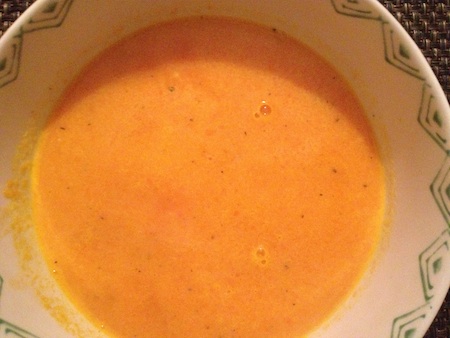
Soup comes chunky, thick, smooth, and thin varieties. But now, according to my daughter, soup can also be described as “fuzzy.” I made Herbed Carrot Soup, used my Cuisinart Smart Stick Hand Blender, and decided to leave a bit of texture instead of pureeing to complete smoothness. My choice was accepted by some at the table, and rejected by others.
We’ve come to expect certain foods to have a certain texture, and those expectations play into whether or not we like the food. Texture of a food is also related to its quality – as the texture of something can change if it is no longer ripe or fresh and ready to eat — think of a mealy apple or a soft, squishy banana. How about wilted lettuce, hard bread, and gritty ice cream that has has grown ice crystals?
Foods in which texture is the dominant quality characteristic include meat, potato chips, or celery. For others, such as fruits, vegetables, cheeses and candy, texture may be important, but not a dominant characteristic. Those where texture makes a negligible contribution to the overall quality include most beverages and . . . soup, unless you were at our table the other night when I served fuzzy carrot soup.
Texture is important component in cooking and one that has a direct relationship to how well something is enjoyed. I remember a few years back when Chef Miki of Melissa’s was working with Janet and Jim, the empty nesters who took part in our first Family Eats Challenge. Jim was a picky eater, and as Chef Miki found out, much of the reason Jim was not eating a lot of foods is because of the texture.
Generally, Jim did not like foods that have competing textures – which is probably why he did not like casseroles or pot pies. Now, several years later, Janet and Jim still incorporate what Chef Miki has taught them, and we’re happy to report that they are both enjoying more foods – especially after dealing with texture of certain foods.
From an eater’s perspective, texture is evaluated when it chewed. As explained on Food Science, “The teeth, tongue and jaw exert a force on the food, and how easily it breaks or flows in the mouth determines whether it is perceived as hard, brittle, thick, runny, and so on. The term mouthfeel is a general term used to describe the textural properties of a food as perceived in the mouth.”
Clearly, our sensory acceptance of food texture is extremely important in our enjoyment of foods.
In interviews conducted with ‘home-makers’ Szczesniak and Kahn (1971), the texture of food is the way people have learned to expect it to be. If the texture of the food is not as it is expected to be, it becomes a focal point for criticism and rejection of the food.
We enjoy all types of textures – and have come to expect certain textures for foods (like my carrot soup). And, as I found out on our fuzzy soup night, the texture was a key determinant on whether or not my girl would continue to eat the soup, regardless of what it actually tasted like.
I came across reference to an interesting study relating texture and flavor. Schiffman (1977; Schiffman et al., 1978) fed 29 different foods to people who had been blindfolded and asked them to identify the foods based on flavor. The samples had been pureed by blending and straining in order to eliminate textural clues. What was discovered was interesting – those in the study did a poor job of identifying the food when the texture and color were concealed, and flavor was the only attribute used for identification. For instance, young adults were able to identify correctly only 40.7% of the foods used in the study. Only 4% of respondents could identify cabbage by flavor only. Similarly, only 15% for pork, 41% for beef, and 51% for carrots.
Which gets me back to my fuzzy carrot soup. In the Schiffman study, flavor seemed to be of secondary importance – as it did for two of my children. What turned them off was the fuzzy texture, because their expectation of what they would taste was a soup with a creamy, smooth texture, i.e., the carrot soup looked as if it had a smooth texture. (We eat chunky soups, too.)
From this Carrot Soup Observation during dinner last week, I am reminded that I must not underestimate the importance of texture.





